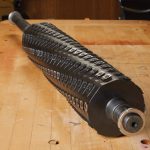We may receive a commission when you use our affiliate links. However, this does not impact our recommendations.

After allowing the glue to set, I carefully removed the clamped molding from the guitar maker’s vise. At this point, I removed excess wood from the glued-up block using a bandsaw to refine its shape. With the block now trimmed to the desired dimensions, I brought it to my bench for the shaping process. Referencing diagram (A), my goal was to recreate the intended cross-section of the molding. 
 Moving to diagram (B), you’ll notice the glued-up section of the broken molding containing both the old molding and the new block that was glued to it (on the right). To start, I planed the top of the glued-up block flush with the molding surface.
Moving to diagram (B), you’ll notice the glued-up section of the broken molding containing both the old molding and the new block that was glued to it (on the right). To start, I planed the top of the glued-up block flush with the molding surface.

In diagram (C), I utilized a shoulder plane to rabbet a step. To ensure precision, I used rulers and depth gauges, such as a combination square, to verify that the newly milled planes and surfaces (the rabbet’s tread and riser) aligned seamlessly with the original molding’s rabbet. Once the rabbet was established, I proceeded to round over the ledge geometry of the molding, aptly known as a Thumb (D), using the shoulder plane.




Moving on to diagram (E), I continued by using the shoulder plane to craft a rabbet at the underside of the Thumb. This step also presented an opportunity to round over the bottom of the Thumb, ensuring a flush and seamless integration.








Round over the bottom of the Thumb.



As illustrated in diagram (F), the next step involved creating the final rabbet at the bottom of the molding, marking progress in shaping the bottom section.

Using a marking gauge to score a trench along the edge allowed me to nest my shoulder plane’s corner, providing a directional track to begin saving the wood. With every advance of the plane, I gradually pivoted its angle until it was aligned with the rabbet. Then, I proceeded to remove more shaving until the rabbet was completed.


 In the upcoming steps, I will detail the continuation of the shaping process, illustrating how the new edition evolves to match the profile of the original molding perfectly.
In the upcoming steps, I will detail the continuation of the shaping process, illustrating how the new edition evolves to match the profile of the original molding perfectly.
Here are some supplies and tools we find essential in our everyday work around the shop. We may receive a commission from sales referred by our links; however, we have carefully selected these products for their usefulness and quality.










